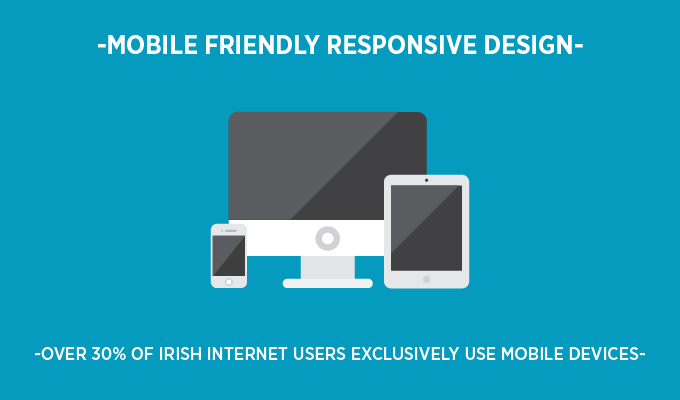Every wonder what factors contribute to a successful eCommerce website. In this article we give you the statistics behind profitable eCommerce websites in ‘7 Crucial Factors In Successful eCommerce Websites’.

1. Mobile Friendly Responsive Design
Over 30% of all Irish internet users exclusively use mobile devices to browse the internet. This means up to a third of every website’s audience, view the site on a tablet or mobile device. If the website being viewed is not mobile friendly then there is an extremely high likelihood that the viewer will leave. Having a website that is not mobile friendly can also hamper a sites ranking in on search engine giant, Google. As of early 2015 Google has introduced a new ranking structure on mobile and tablet devices. This new system means that websites that are not mobile friendly will rank lower than mobile friendly websites when search on all mobile devices. So to sum things up, not having a mobile friendly website can lead to a massive bounce rate and low ranking on mobile and tablet devices.
Source: StatCounter

2. Fast Loading Time
According to reputable online statistics journal Econsultancy, “40% of people will abandon a web page if it takes more than three seconds to load”. This is a damning statistic if your website is sluggish on loading time. Poor loading speed can be down to numerous key factors such as hosting, neglected website maintenance, lack of a caching system, image sizes and not following basic web design and development protocols. You can have the best website that money can buy, but this will not matter if the website is sluggish.
Source: Econsultancy

3. SEO
SEO has a huge baring on whether your eCommerce website will be found through search engines or not. According to award winning online blogger Hubspot up to “75% of users never scroll past the first page of search results”. This means that if your website is not one the first page of search engines like Google, then you will not get the amount of traffic that someone on the first page will get. SEO optimisation is a long process and to expect to appear on page one of Google overnight is not realistic. Climbing the rankings is a hard process that involves an SEO expert fine tuning numerous aspects of your website including the content, keywords, speed, index system, etc. Stop gap solutions of payed advertising can act as a temporary solution, but prices on these ads can vary depending on the demand.
Source: Hubspot

4. Landing Pages
A landing page is a webpage that acts as the entry point for each website viewer. A website can have multiple landing pages that serve to show the audience a special offer or introduce them to a particular service or product the website is trying to sell. According to MarketingSherpa, “48% of marketers build a new landing page for each marketing campaign”. This means that a company selling four products might have four different pages to make sure their target audience find the specific product. Gateways to landing pages can be lead from email marketing campaigns, social media offers or specific URL’s (website addresses). Landing pages ensure that prospective clients find your products or services without having the hassle of filtering through a website, increasing your buy rate exponentially.
Source: MarketingSherpa

5. Social Media Integration
Social media has a huge baring in persuading your audience to purchase a product from your eCommerce website. According to Nielsen, “Approximately 46% of online users count on social media when making a purchase decision”. For example having a Facebook like counter next to a product with a significant amount of likes tells the viewer that the product is trustworthy. Having a product that is visibly liked by others can be the difference between selling and not selling a product. Social media integration also allows the user to share the product or service they purchased on social media, encouraging their online friends to view the product.
Source: Nielsen

6. A Blog
The importance of an eCommerce website blog cannot be understated. Blogging helps bring traffic to your eCommerce website and should be an integral part of every sites SEO plan. According to Hubspot, “Companies that blog have 434% more indexed pages. And companies with more indexed pages get far more leads”. Basically this means the more original and engaging content that a website has, the easier it is for Google to crawl your site and rank it higher.
Source: Hubspot
7. Lead Nurturing
Lead nurturing is a marketing term for coaxing prospective clients into committed sales through sustained and informative marketing campaigns. These marketing campaigns for eCommerce websites usually consist of informative emails listing the benefits of a product or service. These emails are sent to leads that are separated through custom data entry on email marketing platforms such as Mailchimp. According to DemandGen Report “Nurtured leads produce, on average, a 20% increase in sales opportunities versus non-nurtured leads”.
Source: DemandGen Report
For any more information regarding the 7 Crucial Factors In Successful eCommerce Websites or any other information on our services feel free to call Opus Creative on +353 (21) 242 8689 or email us on hello@opuscreative.ie



